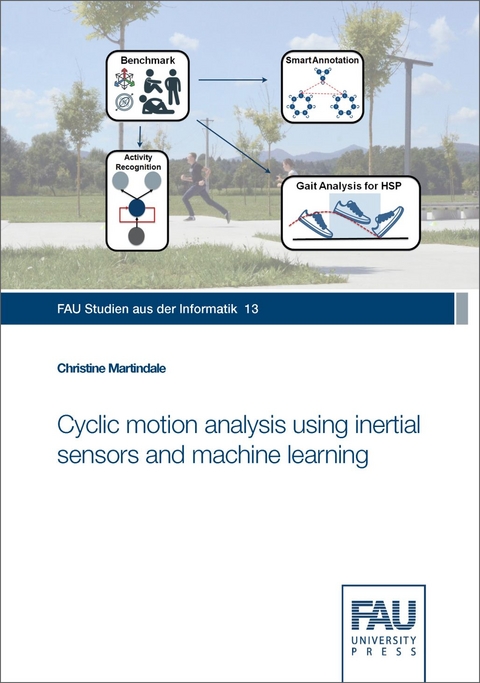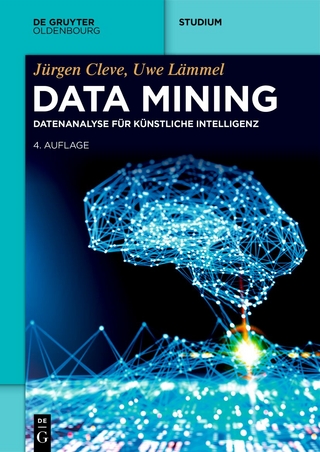
Cyclic motion analysis using inertial sensors and machine learning
Seiten
2020
Fau University Press (Verlag)
978-3-96147-299-4 (ISBN)
Fau University Press (Verlag)
978-3-96147-299-4 (ISBN)
Cyclic motions such as walking, running or cycling are common to our daily lives. Thus, the analysis of these cycles has an important role to play within both the medical field, e.g. gait analysis, and the fitness domain, e.g. step counting and running analysis. For such applications, inertial sensors are ideal as they are mobile and unobtrusive. The aim of this thesis is to capture cyclic motion using inertial sensors and subsequently analyse them using machine learning techniques.
A lack of realistic and annotated data currently limits the development and application of algorithms for inertial sensors under non-laboratory conditions. This is due to the effort required to both collect and label such data. The first contributions of this thesis propose novel methods to reduce annotation costs for realistic datasets, and in this manner enable the labelling of a large benchmark dataset. The applicability of the dataset is demonstrated by using it to propose and test a robust algorithm for simultaneous human activity recognition and cycle analysis. One of these methods for reducing annotation costs is then deployed to develop the first mobile gait analysis system for patients with a rare and heterogeneous disease, hereditary spastic paraplegia (HSP).
Thus, machine learning algorithms which set the state-of-the-art for cycle analysis using inertial sensors were proposed and validated by this thesis. The outcomes of this thesis are beneficial in both the medical and fitness domains, enabling the development and use of algorithms trained and tested in realistic settings.
Zyklische Bewegungen wie Gehen, Laufen, Radfahren werden im Alltag sowohl im medizinischen Bereich, z.B. Ganganalyse, als auch im Fitnessbereich, z.B. Schrittzählung, analysiert. Für solche Anwendungen sind Inertialsensoren ideal, da sie mobil und unauffällig einsetzbar sind. Fehlende annotierte Daten aus dem Alltag schränken die Entwicklung und Anwendung von Algorithmen für solche Sensoren unter nicht-laborbedingungen ein. Dies ist auf den Aufwand zurückzuführen, der bei der Erhebung und Annotation solcher Daten anfällt.
Das Ziel dieser Arbeit ist es, die Annotationskosten für realistische Datensätze zu reduzieren, um so einen großen Benchmark-Datensatz zu sammeln und seine Relevanz zu demonstrieren. Es wird ein robuster Algorithmus für die Erkennung menschlicher Aktivität und simultaner Zyklusanalyse vorgeschlagen. Weiter wird das erste mobile Ganganalysesystem für Patienten mit einer seltenen und heterogenen Krankheit, der hereditären spastischen Querschnittslähmung (hereditary spastic paraplegia (HSP)) vorgeschlagen.
So werden maschinelle Lernalgorithmen erforscht und validiert, die den Stand der Technik für die Zyklusanalyse mit Inertialsensoren ergänzen. Die Ergebnisse dieser Arbeit sind sowohl im medizinischen als auch im Fitnessbereich von Nutzen, um Algorithmen zu entwickeln, die in realistischen Umgebungen trainiert und getestet werden können.
A lack of realistic and annotated data currently limits the development and application of algorithms for inertial sensors under non-laboratory conditions. This is due to the effort required to both collect and label such data. The first contributions of this thesis propose novel methods to reduce annotation costs for realistic datasets, and in this manner enable the labelling of a large benchmark dataset. The applicability of the dataset is demonstrated by using it to propose and test a robust algorithm for simultaneous human activity recognition and cycle analysis. One of these methods for reducing annotation costs is then deployed to develop the first mobile gait analysis system for patients with a rare and heterogeneous disease, hereditary spastic paraplegia (HSP).
Thus, machine learning algorithms which set the state-of-the-art for cycle analysis using inertial sensors were proposed and validated by this thesis. The outcomes of this thesis are beneficial in both the medical and fitness domains, enabling the development and use of algorithms trained and tested in realistic settings.
Zyklische Bewegungen wie Gehen, Laufen, Radfahren werden im Alltag sowohl im medizinischen Bereich, z.B. Ganganalyse, als auch im Fitnessbereich, z.B. Schrittzählung, analysiert. Für solche Anwendungen sind Inertialsensoren ideal, da sie mobil und unauffällig einsetzbar sind. Fehlende annotierte Daten aus dem Alltag schränken die Entwicklung und Anwendung von Algorithmen für solche Sensoren unter nicht-laborbedingungen ein. Dies ist auf den Aufwand zurückzuführen, der bei der Erhebung und Annotation solcher Daten anfällt.
Das Ziel dieser Arbeit ist es, die Annotationskosten für realistische Datensätze zu reduzieren, um so einen großen Benchmark-Datensatz zu sammeln und seine Relevanz zu demonstrieren. Es wird ein robuster Algorithmus für die Erkennung menschlicher Aktivität und simultaner Zyklusanalyse vorgeschlagen. Weiter wird das erste mobile Ganganalysesystem für Patienten mit einer seltenen und heterogenen Krankheit, der hereditären spastischen Querschnittslähmung (hereditary spastic paraplegia (HSP)) vorgeschlagen.
So werden maschinelle Lernalgorithmen erforscht und validiert, die den Stand der Technik für die Zyklusanalyse mit Inertialsensoren ergänzen. Die Ergebnisse dieser Arbeit sind sowohl im medizinischen als auch im Fitnessbereich von Nutzen, um Algorithmen zu entwickeln, die in realistischen Umgebungen trainiert und getestet werden können.
| Erscheinungsdatum | 24.09.2020 |
|---|---|
| Reihe/Serie | FAU Studien aus der Informatik ; 13 |
| Sprache | deutsch |
| Maße | 2100 x 1480 mm |
| Gewicht | 422 g |
| Themenwelt | Informatik ► Datenbanken ► Data Warehouse / Data Mining |
| Informatik ► Weitere Themen ► Bioinformatik | |
| Schlagworte | Beschleunigungssensor • Bewegungsstörung • Ganganalyse • Gelenkendoprothese • Gelenkkrankheit • ´Maschinelles Lernen • Motion Capturing • Validierung |
| ISBN-10 | 3-96147-299-8 / 3961472998 |
| ISBN-13 | 978-3-96147-299-4 / 9783961472994 |
| Zustand | Neuware |
| Informationen gemäß Produktsicherheitsverordnung (GPSR) | |
| Haben Sie eine Frage zum Produkt? |
Mehr entdecken
aus dem Bereich
aus dem Bereich
Auswertung von Daten mit pandas, NumPy und IPython
Buch | Softcover (2023)
O'Reilly (Verlag)
44,90 €
Datenanalyse für Künstliche Intelligenz
Buch | Softcover (2024)
De Gruyter Oldenbourg (Verlag)
74,95 €


